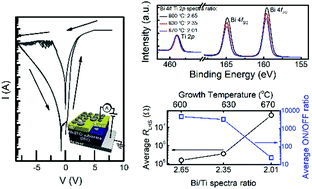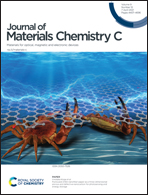High performance, electroforming-free, thin film memristors using ionic Na0.5Bi0.5TiO3†
Abstract
Here, in ionically conducting Na0.5Bi0.5TiO3 (NBT), we explore the link between growth parameters, stoichiometry and resistive switching behavior and show NBT to be a highly tunable system. We show that the combination of oxygen ionic vacancies and low-level electronic conduction is important for controlling Schottky barrier interfacial switching. We achieve a large ON/OFF ratio for high resistance/low resistance (RHRS/RLRS), enabled by an almost constant RHRS of ∼109 Ω, and composition-tunable RLRS value modulated by growth temperature. RHRS/RLRS ratios of up to 104 and pronounced resistive switching at low voltages (SET voltage of <1.2 V without high-voltage electroforming), strong endurance (no change in resistance states after several 103 cycles), uniformity, stable switching and fast switching speed are achieved. Of particular interest is that the best performance is achieved at the lowest growth temperature studied (600 °C), which is opposite to the case of most other perovskite oxides for memristors, where higher growth temperatures are required for optimum performance. This is understood based on the oxygen vacancy control of interfacial switching in NBT, whereas a range of other mechanisms (including filamentary switching) occur in other perovskites. The study of NBT has enabled us to determine key parameters for achieving high performance memristors.



 Please wait while we load your content...
Please wait while we load your content...